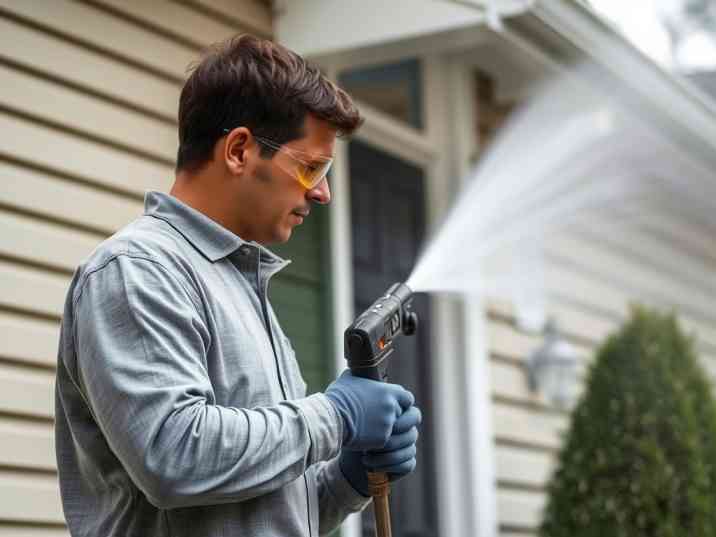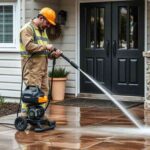When it comes to exterior cleaning, the terms “power washing” and “pressure washing” are often used interchangeably. However, these two methods are not identical, and understanding their differences is crucial for selecting the right cleaning solution for your needs. Whether you’re a homeowner looking to refresh your driveway or a business owner maintaining commercial property, knowing the nuances between power washing and pressure washing can save time, money, and potential damage to surfaces. In this comprehensive guide, we’ll break down the distinctions, explore their applications, and provide insights into which method suits specific scenarios.
What Are Power Washing and Pressure Washing?
At first glance, both power washing and pressure washing involve using high-pressure water streams to clean surfaces. However, the key difference lies in the use of heat.
Pressure Washing
Pressure washing utilizes cold water propelled at high pressure to remove dirt, grime, mildew, and other contaminants from surfaces. This method is highly effective for lighter cleaning tasks, such as washing driveways, sidewalks, and fences. The absence of heat makes it suitable for materials that may be sensitive to temperature changes, such as wood or certain types of paint.
Power Washing
Power washing, on the other hand, incorporates heated water into the equation. The addition of heat enhances the cleaning process by breaking down grease, oil, and stubborn stains more effectively. This makes power washing ideal for tougher jobs, such as removing oil spills from garage floors, cleaning industrial equipment, or sanitizing outdoor spaces prone to mold and mildew.
While the fundamental mechanism—high-pressure water—is the same, the inclusion of heat in power washing sets it apart and expands its range of applications.

Key Differences Between Power Washing and Pressure Washing
To better understand the distinction, let’s examine the primary factors that differentiate these two cleaning methods:
1. Temperature of Water
- Pressure Washing: Uses cold water exclusively. This makes it a safer option for delicate surfaces or environments where heat could cause damage.
- Power Washing: Employs heated water, which increases the cleaning efficiency by softening grease, oil, and other substances that cold water alone cannot tackle.
2. Cleaning Efficiency
- Pressure Washing: Effective for general cleaning tasks but may struggle with deeply embedded stains or oily residues.
- Power Washing: Provides superior cleaning power due to the combination of heat and pressure, making it the go-to choice for heavy-duty jobs.
3. Applications
- Pressure Washing: Best suited for residential projects like cleaning patios, decks, and siding. It’s also commonly used for preparing surfaces for painting or sealing.
- Power Washing: Ideal for industrial or commercial settings, such as cleaning warehouses, factories, and restaurant exteriors. It’s also effective for sanitizing outdoor furniture and equipment.
4. Equipment Requirements
- Pressure Washing: Typically involves simpler machinery, often electric-powered, which is easier to operate and maintain.
- Power Washing: Requires more advanced equipment capable of heating water, usually gas-powered, which can be bulkier and more expensive.
5. Environmental Impact
- Pressure Washing: Generally considered more eco-friendly since it uses only water and detergents (if necessary).
- Power Washing: While highly effective, the use of heated water consumes more energy, which may raise environmental concerns if not managed responsibly.
When to Choose Pressure Washing
Pressure washing is an excellent choice for a variety of everyday cleaning tasks. Here are some scenarios where it shines:
1. Residential Cleaning
Homeowners frequently rely on pressure washing to clean driveways, sidewalks, and patios. These areas accumulate dirt, algae, and moss over time, and pressure washing restores their appearance without risking damage.
2. Preparing Surfaces for Renovations
Before painting or sealing outdoor surfaces, pressure washing ensures they are free of dirt, loose paint, and contaminants. This step is critical for achieving smooth, long-lasting results.
3. Delicate Materials
For surfaces like wooden decks or painted walls, pressure washing is preferable because the absence of heat reduces the risk of warping or discoloration.
4. Light Commercial Use
Small businesses with minimal cleaning needs, such as storefronts or office exteriors, can benefit from pressure washing without the added cost of heated water.
When to Choose Power Washing
Power washing takes cleaning to the next level, making it indispensable for challenging tasks. Consider power washing in the following situations:
1. Industrial and Commercial Projects
Factories, warehouses, and restaurants often deal with grease, oil, and food residue. Power washing cuts through these substances efficiently, ensuring compliance with health and safety standards.
2. Sanitization Needs
Outdoor spaces prone to mold, mildew, or bacteria require thorough sanitization. The heat in power washing not only cleans but also kills germs, making it a hygienic choice.
3. Tough Stains and Residues
Oil spills, tar, and gum are notoriously difficult to remove. Power washing’s combination of heat and pressure breaks down these substances, restoring surfaces to their original condition.
4. Seasonal Maintenance
In regions with harsh winters, power washing is ideal for removing salt, ice melt, and road grime from driveways and walkways. The heat helps dissolve stubborn residues left behind by de-icing chemicals.
Advantages of Each Method
Both power washing and pressure washing offer unique benefits depending on the task at hand. Let’s explore their respective advantages:
Advantages of Pressure Washing
- Cost-Effective: Since it doesn’t require heating elements, pressure washing equipment is generally more affordable to purchase and operate.
- Eco-Friendly: Cold water usage reduces energy consumption, making it a greener option.
- Versatile: Suitable for a wide range of surfaces, including those that may be sensitive to heat.
Advantages of Power Washing
- Enhanced Cleaning Power: The addition of heat significantly boosts the ability to remove tough stains and sanitize surfaces.
- Time-Saving: Power washing achieves faster results compared to pressure washing, especially for heavy-duty tasks.
- Hygiene Benefits: Kills bacteria and mold spores, creating a cleaner and healthier environment.

Potential Risks and Precautions
While both methods are highly effective, improper use can lead to unintended consequences. Here are some risks and precautions to keep in mind:
1. Surface Damage
High-pressure water can strip paint, etch concrete, or damage delicate materials. Always adjust the pressure and nozzle angle based on the surface being cleaned.
2. Safety Hazards
Operating power washers and pressure washers requires caution. The force of the water stream can cause injuries if directed at skin or eyes. Wear protective gear and follow manufacturer guidelines.
3. Environmental Concerns
Runoff water containing chemicals or debris can contaminate local water sources. Use eco-friendly detergents and dispose of wastewater responsibly.
Which Method Should You Choose?
The decision between power washing and pressure washing ultimately depends on your specific needs and the nature of the project. For routine maintenance and lighter cleaning tasks, pressure washing is sufficient and cost-effective. However, for industrial applications, sanitization requirements, or stubborn stains, power washing is the clear winner.
If you’re unsure which method to choose, consulting a professional cleaning service can provide clarity. Experienced operators assess the situation and recommend the most appropriate approach, ensuring optimal results without compromising safety or quality.
Conclusion
Understanding the difference between power washing and pressure washing empowers you to make informed decisions about your cleaning needs. While both methods share similarities, their distinct features cater to different scenarios. Pressure washing excels in versatility and eco-friendliness, making it ideal for residential and light commercial use. Power washing, with its added heat, delivers unmatched cleaning power for tougher jobs and industrial applications.
By leveraging the strengths of each method, you can achieve pristine results while preserving the integrity of your surfaces. Whether you opt for DIY solutions or professional services, proper technique and equipment selection are key to success.



